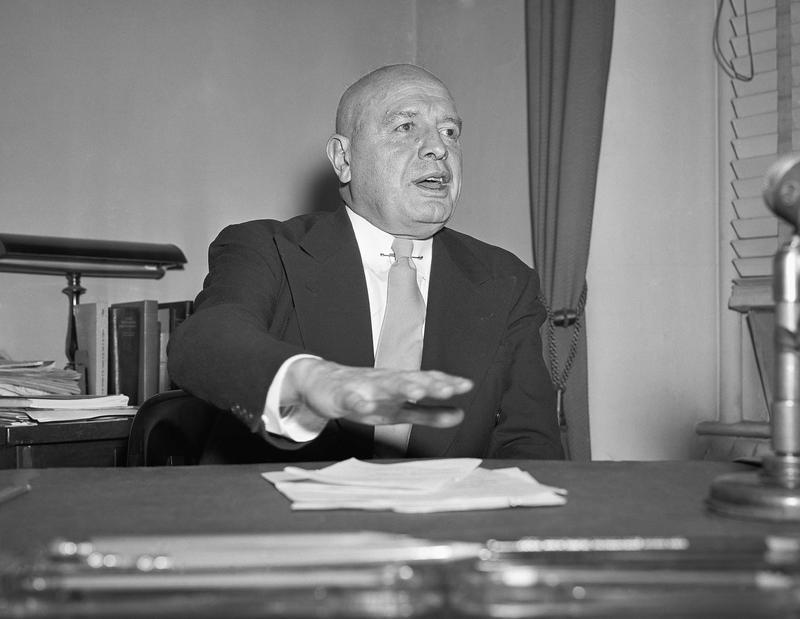The Man Who Declared War On Drugs

( AP Images )
BOB GARFIELD: This is On the Media. I’m Bob Garfield.
BROOKE GLADSTONE: And I'm Brooke Gladstone. The origins of the seemingly eternal “war on drugs” actually could be traced to one man.
[CLIP]:
MAN: First, come behind the scene at Washington, DC and meet the chief of the US Federal Bureau of Narcotics, Mr. Harry J. Anslinger.
[END CLIP]
BROOKE GLADSTONE: At the age of 38, Harry Anslinger was appointed the first commissioner of the nation's new Federal Bureau of Narcotics in 1930. He often framed drug abuse as a foreign menace.
[CLIP]:
HARRY J. ANSLINGER: The chief problem, as we see it, is to determine the country of origin of smuggled opium because that is the source of all the illicit traffic, not only in this country but in the whole world.
[END CLIP/MUSIC UP & UNDER]
BROOKE GLADSTONE: But to understand Anslinger’s rise, and rise he did, we have to consider what preceded him. In the mid-19th century, Americans treated substance abuse, largely opiates, with compassion because it was an affliction wrought in part by the Civil War.
ALEXANDRA CHASIN: A lot of soldiers became addicted and remained addicted after the war and there was a fair amount of sympathy for it.
BROOKE GLADSTONE: Alexandra Chasin is the author of Assassin of Youth: A Kaleidoscopic History of Harry J. Anslinger’s War on Drugs.
ALEXANDRA CHASIN: If anything, they were referred to as “habitués,” people who had become habituated to opiates, but it was not a particularly pejorative term.
BROOKE GLADSTONE: Medical professionals were far less concerned with ending addiction than with managing the pain.
ALEXANDRA CHASIN: Maintenance was a longstanding practice on the part of physicians who prescribed narcotics, often just to stave off the withdrawals that would occur if people went off drugs suddenly.
BROOKE GLADSTONE: In 1875, San Francisco passed the nation's first piece of prohibitionist legislation. It outlawed Chinese opium dens but not the private sale and use of the drug.
ALEXANDRA CHASIN: Following the Gold Rush and during times of intensive labor on the transcontinental railroad, lots of Chinese people came to the United States to work, and they came to the West Coast first.
[CHINESE MUSIC/UP & UNDER]
It was perceived that Chinese were underselling their labor, making it difficult for native-born Americans to receive adequate wages.
BROOKE GLADSTONE: And so, opium was something that they could use to whip up fear, and that did that in a really familiar way.
ALEXANDRA CHASIN: Opium smoking-Chinese people were thought to be inducting white women into the dangers of opium smoking. White people also consumed opium but they tended to take it in other forms, for example, laudanum. A whole heap of them took laudanum.
BROOKE GLADSTONE: For “the vapors.”
ALEXANDRA CHASIN: Yes.
[MUSIC OUT]
BROOKE GLADSTONE: From the late 19th century into the 20th, most opiate addicts were middle-aged middle and upper class women but, as would happen ever after, the new drug laws were far more about race than drugs. So as itinerant workers and urban African Americans became another visible group of drug users, the laws grew harsher. The Harrison Act of 1914 was passed, the first to link drugs and criminality. It came down hard on habituated drug users and their physicians, turning them both into criminals overnight.
ALEXANDRA CHASIN: Tens of thousands of cases in which physicians were tried for prescribing maintenance levels of drugs. The Feds were opposed to this use of narcotics and the Harrison Act created the doctors as the first dealers.
BROOKE GLADSTONE: And all this brings us then to Harry Anslinger, who is the first commissioner of the Bureau of Narcotics, and he’s there from 1930 to 1962, through five presidencies.
ALEXANDRA CHASIN: Anslinger was a very effective bureaucrat. He didn't have any substantive background in the problem of drugs. His background was in prohibition.
BROOKE GLADSTONE: The child of the temperance movement, according to his creed, only the depraved drank booze. Those with strong moral constitutions did not.
ALEXANDRA CHASIN: He carried with him a bunch of ideas into office and he turned them into the foundation of prohibitionist drug policy and law.
BROOKE GLADSTONE: Throughout the Great Depression, Anslinger’s op-eds and speeches presented narcotics as the agents of certain death dispatched by alien aggressors. By this calculation, drug dealers were not just venal, they were evil.
[CLIP]:
HARRY J. ANSLINGER: The Treasury Department intends to pursue a relentless warfare against the despicable dope-peddling vulture who preys on the weakness of his fellow man.
[END CLIP]
BROOKE GLADSTONE: Anslinger focused his crusading lens on one drug in particular, one grown naturally across the nation, known at the time by such names as hop, gage, mez, juju, muggle, tea and reefer. But he claimed it had been newly introduced to our shores by Mexican laborers.
ALEXANDRA CHASIN: He put marijuana on the map. It didn't really exist before as a social problem, and so he got to define the problem. In fact, marijuana wasn't marijuana at the time. Anslinger is responsible for that coinage, which has the effect of linking cannabis with Latinos.
BROOKE GLADSTONE: Not only was he certain that it corrupted youth and increased crime, he also saw criminalizing pot as a means to revive his dwindling agency. When alcohol was legalized in 1933, the funding of the Federal Bureau of Narcotics was slashed. Since alcohol was being rehabilitated, Anslinger needed a new threat to combat. He dramatized the marijuana threat in a widely-read article called, “Assassin of Youth.”
ALEXANDRA CHASIN: I’d like to read from the beginning of “Assassin of Youth.” “Not long ago, the body of a young girl lay crushed on the sidewalk after a plunge from a Chicago apartment window. Everyone called it suicide but, actually, it was murder.
BROOKE GLADSTONE: Da-duh!
ALEXANDRA CHASIN: The killer was a narcotic known to America as marijuana and to history as hashish.” It makes all of Harry's most typical moves. Right at the beginning, we have, again, the threat to white women realized.
BROOKE GLADSTONE: And on the hells of “Assassin of Youth” came a movie.
[PROPAGANDA CLIP]:
MAN: The truth is that every reefer is loaded with immorality and bestial perversions, brutality, murder, sex crimes, insanity or suicide.
[END CLIP]
BROOKE GLADSTONE: Anslinger’s anti-pot propaganda yielded a major policy shift. In 1937, Congress effectively criminalized the drug with the Marijuana Tax Act. Still, his rhetoric did draw criticism, so he doubled down by publicly denouncing conflicting medical research.
ALEXANDRA CHASIN: Mayor LaGuardia commissioned a report in 1937 of marijuana and discovered that marijuana did not make people criminally insane. That report didn't see print until 1944 because Anslinger did not want it to.
BROOKE GLADSTONE: Most of his racism was betrayed through his draconian enforcement, his coded rhetoric and the policies within the Bureau; he didn't let the few black agents he had upstairs. But, boy, if you want to see jazz as a stand-in for black, did he hate jazz.
[JAZZ MUSIC UP & UNDER]
He said the lives of jazzmen reeked of filth and that the music sounded like the jungles of the night.
ALEXANDRA CHASIN: And it reeked of something else, as well.
[LAUGHTER]
[“REEFER MAN” CLIP]:
CAB CALLOWAY, SINGING:
Oh have you ever met that funny reefer man?
Reefer man
Have you ever met that funny reefer man?
Reefer man…
[MUSIC UP & UNDER]
If he said he swam to China, and he sell you South Carolina
Then you know you’re talkin’ to that reefer man.
BROOKE GLADSTONE: Coloreds with big lips, he told Congress, lure white women with jazz and marijuana. Anslinger set his sights on persecuting several musicians, Charlie Parker, Louis Armstrong, Thelonious Monk, Dizzy Gillespie, Duke Ellington.
JOHANN HARI: If you want to understand Harry Anslinger, the most influential person who no one’s ever heard of, and you want to understand the origins of the war on drugs, I think you have to look at the story of what he did to Billie Holiday.
BROOKE GLADSTONE: That’s Johann Hari, author of Chasing the Scream: The First and Last Days of the War on Drugs.
JOHANN HARI: In 1939, Billie Holiday worked onstage in a hotel in Manhattan Midtown where she wasn’t even allowed to walk through the front door ‘cause she was African American and they made her go through the service elevator. And she sang the song that your listeners are gonna know. It’s called “Strange Fruit.” It’s a song against lynching.
[CLIP]:
BILLIE HOLIDAY, SINGING:
Southern trees bear strange fruit
Blood on the leaves and blood at the root
Black bodies swinging in the southern breeze
Strange fruit hanging from the poplar trees
[END CLIP]
JOHANN HARI: That night, Billie holiday received a warning from Harry Anslinger’s men, and it basically said, stop singing this song.
BROOKE GLADSTONE: What did it have to do with the war on drugs?
JOHANN HARI: To Harry Anslinger, Billie holiday was like the symbol of everything that America had to be afraid of. She had a heroin addiction because she'd been chronically raped as a child and she was trying to deal with the grief and the pain of that. And also, she was resisting white supremacy. And when she insisted on continuing on her right as an American citizen to sing “Strange Fruit,” Anslinger resolves to destroy her.
You have to understand that he was regarded as an extreme racist in the 1920s. He used the N word so often in official memos that his own senators said he should have to resign. So although he hated employing African Americans, he employs a man called Jimmy Fletcher. He was what they called a bagman. And for two years, Jimmy Fletcher stalks Billie Holiday, on Harry Anslinger’s orders. Jimmy Fletcher fell in love with her and his whole life he felt ashamed of what he did next. He busts her. She was convicted. She’s sent to prison. She gets out. And to perform anywhere where alcohol was served you needed what was called a cabaret performer’s license. And Harry Anslinger makes sure she doesn't get a cabaret performer’s license, and they take away singing from Billie Holiday. She naturally relapses. Of course, how could she not? And a few years later, she actually collapsed in Manhattan. She’s taken to hospital. She says to one of her friends, Maely Dufty, they’re gonna kill me in there. She’s convinced that Anslinger’s men are not finished with her.
She’s diagnosed with very advanced liver cancer and she starts to go into heroin withdrawal. So she’s given methadone and she starts to recover. And then Anslinger’s men cut it off.
BROOKE GLADSTONE: Federal Bureau of Narcotics agents fingerprinted Holiday, took her mug shot in bed and grilled her without a lawyer present. Not long after, on July 17th, 1959, Billie Holiday died in that hospital bed.
JOHANN HARI: My favorite hypocrisy about Harry Anslinger is later in his life he developed angina and the doctor prescribed him really powerful opiates.
[BROOKE LAUGHS]
He took them very happily, and I sometimes wonder, when he first injected himself with opiates, years after Billie Holiday had died, did he think about Billie Holiday, did she cross his mind? I sometimes wonder about that.
BROOKE GLADSTONE: Johann Hari, author of Chasing the Scream: The First and Last Days of the War on Drugs.
[MUSIC UP & UNDER]
BOB GARFIELD: Coming up, can incarceration or treatment cure what ails us? Or is that the wrong question?

